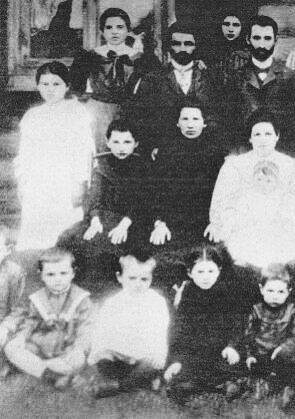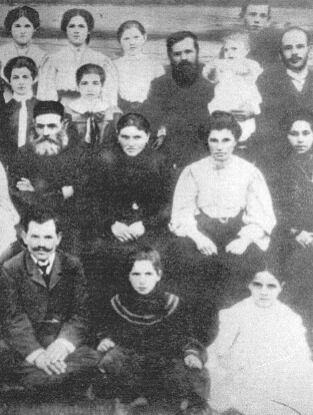


| 
|
"ICH GEDANK" (Translated from Yiddish, I REMEMBER)...
This is how my aunt, Mildred Eisenshtadt Schumann, began every story about David-Horodok. The information in this photograph was handed down to me verbally by her. Although she has been gone over twenty-five years, I never forgot the stories she told me about David-Horodok. I hope I never will...
This photograph represents the family of Moishe Lifshitz, my great-grandfather, (center with arms folded) who was marrying off his granddaughter, who was orphaned. The bride is sitting in the same row as my great-grandfather, far right, seated, dressed in black and the groom (partially bald) is standing directly behind her. I do not know their first names, but their married name was Blazofsky (pronounced BLA-jof-sky). I had the opportunity of meeting their son, Asher Blazofsky, in Israel in 1976, the year before he died. As he was born in 1907, I am estimating that this photograph was taken in either 1905 or 1906. When asked why the bride was dressed in black instead of white, Aunt Mildred told me that was the custom (although I find it hard to believe).
My great-grandfather Moishe Lifshitz was a widower who was known for his piety. He owned the post office in David-Horodok. The famous Stoliner Rebbe would stay at his home when traveling from shtetl to shtetl. My aunt was always proud of the fact that she came from "yechis" (loosely defined as class, prestige.) Yechis had nothing to do with material wealth.
My grandmother, Jennie (Gunia) Lifshitz Eisenshtadt, is sitting to the right of her father Moishe. Her sister, Chaya Rochel (last name unknown) is sitting to his left. She is holding a child on her lap. As you can see, the child is sketched in. When I took this photograph to be framed, it was explained to me that often infants would not sit still while being photographed. So, the photographer would remove them. Later, the photographer would sketch in the child. I believe that standing directly in back of Chaya Rochel and to her left are her brothers, Gershon and Shimon Leib Lifshitz (both with beards). Aunt Mildred used to recount that both were handsome men who died young.
My grandfather, Israel (Yisrael) Eisenshtadt, (after whom I am named) was not present at the wedding, as he was away on business. However, life was very difficult and my grandfather barely made a living.
Thanks to the David-Horodoker website, I was able to find the marriage record of my grandparents. They were married on June 26, 1886 (Julian date), or July 8, 1886 (civil date). This corresponded to the Hebrew date of the 5th of Tammuz 5646. My grandfather was 23 years old and my grandmother was 19. This obviously contradicts the story of my aunt that my grandfather was ten years older than my grandmother was.
It has often been said that people who were born in a shtetl did not know their exact dates of birth, as this information was not recorded. Consequently, they often made up a date based on the season of the year. For example, if a child were born around Hanukkah, the month of birth would be December. The day of the month was then made up. However, based on the information above, perhaps there was a better record keeping system for births, deaths, and marriages than originally thought. The birth record of my uncle by marriage, Shimon Dobrushin, even contains the date of his bris (ritual circumcision).
When I was young, Aunt Mildred told me of a story regarding my grandmother that has still left an impact on me. My grandmother had a set of gold earrings. During the First World War, either the Balakovitzes or the Bolsheviks (I can't remember which) were marauding through David-Horodok. One of these marauders noticed the earrings and told my grandmother that if she did not give them to him, he would rip them off of her ears. Needless to say, she gave him the earrings.
My grandmother gave birth to eight (8) children:
My grandparents, Aunts Paiya and Mildred, and my mother came to Detroit in 1922. Aunt Mildred remembered that as the boat was leaving David-Horodok, my great-grandfather Moshe Lifshitz was standing at the shore and crying. When asked if he wanted to come to America, he replied that his burial place was reserved for him in Horodok. In present day David-Horodok, there are no cemetery monuments left standing.
The only other person I think I can identify from the photograph is Sonia Sokolowsky (first row, sitting, far right, in a white dress). She moved to Avignon, France, prior to the war. As France was under Nazi occupation, Sonia, her husband, and children were forced to hide. Miraculously, they all survived the war.
The rest of the family members either died or were killed in the Holocaust. May their souls rest in peace and may their memories serve as a blessing.
I hope that you, the reader, appreciate the rich Jewish history that existed in Eastern Europe years before the Holocaust. It is important that we pass this history from generation to generation. If we will not do it, then who will? We owe it to those who were murdered by the Nazis as well as those who have since passed away.
| Home | List of Tales |